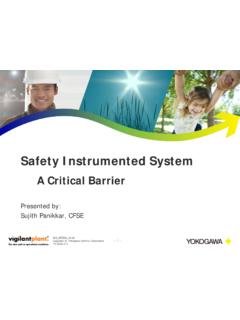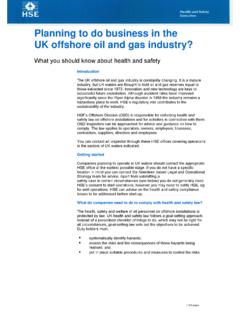Transcription of Use Bow Tie Tool for Easy Hazard Identification
1 Use Bow Tie tool for easy Hazard IdentificationPresented at14thAsia Pacific Confederation of Chemical Engineering CongressSingapore, 21-24 February 2012 Syed Zaiful HamzahPrincipal Risk ConsultantABS Consulting SingaporeEmail: is ABS Consulting? Global Integrity, Safety, Risk Management and Inspection Services Company Serving the Oil & Gas, Petrochemical, Maritime, Power Generation, Commercial, Public and Insurance/Financial Sectors Corporate Headquarters in Houston. Regional HQ in Europe (UK), Middle East (UAE) and Asia (Singapore). Over 1,300 employees, with 50+ offices in some 30 countries Wholly-owned subsidiary of ABS (a Marine and Offshore Classification Society)
2 , founded in Reach and Local Representation4 Range of Services Integrity Management Project Quality Management Inspection & Auditing Operational Asset Integrity Management Reliability & Maintenance Management Independent Verification Services Safety Management HSE Case / Program Development Process Safety Assessment Safety Culture Assessment Management System Development Safety Training Risk Management Enterprise Risk Management Operational Risks Manmade Risks Natural Hazard RisksObjectives of Hazard Identification & Assessment Ensure hazards are known, understood and properly managed Risk is reduced to As Low As Reasonably Practicable (ALARP)Why accidents still happen despite Hazard Identification & assessment being carried out?
3 How do you manage risk? Identify hazards and potential effects -Know & understand the hazards Prevent, mitigate & recover from the hazardous events -Manage the hazardsIdentification of hazards & Potential EffectsKnowing & understanding hazards What are sources of Hazard ? What hazardous event (top event) could potentially occur when a Hazard is released? What could release the Hazard and cause the top event to occur? What are the threats ? What are the consequences from the top event? How severe will the consequences be?Prevention, Mitigation & RecoveryManaging hazards How to avoid the threats (or causes)? prevention or threat barriers How to avoid or minimise the consequences mitigation/recovery barriersOnly possible if hazards are known and understood All Hazard are identified The threat (causes) and consequences of top events are knownManaging hazards Risk ReductionThreatHazardous EventConsequencesThreat Barriers (Prevention)Mitigation & Recovery MeasuresAvoiding the causes; hence, release of hazardMinimising the consequencesHazardHazard You Must Get It Right Having done Hazard Identification /assessment does not guarantee safety Many accidents occurred despite having done Hazard Identification /assessment Why?
4 Failure to identify hazards Failure to manage hazards effectivelyDoing it is not enough, you must get it rightHow Do You Get It right? Identification of hazards and potential effects must be complete All relevant hazards must be identified Threats (causes) & consequences Identification ( Hazard ) analysis must be comprehensive Threat barriers (prevention) & mitigation/recovery barriers must be adequate They must be known to be or confirmed effective Supported by risk assessment to determine ALARPBowTie Methodology .. the Solution Simple & pragmatic approach Empphasis on effectiveness of risk reduction measures Effective visualisation Allows better communication of hazards Can be applied for all types of hazards Increasingly becoming the preferred techniques by regulatory bodies & leading companies Efficiently aided by user-friendly softwares13 Bow Tie Methodology Originated as a technique for developing a Safety Case in the Oil & Gas Industry, post the Piper Alpha Incident in 1988 By linking hazards & Consequences to an Event it is possible to develop the relationship to include the causes, or Threats.
5 And the Prevention & Recovery Measures Further understanding can be gained by examining the means by which these defenses can fail, and identifying the key components which demonstrate the integrity of these controls Documents and Procedures Control Types and Effectiveness Critical Equipment and Systems Tasks and the persons behind the Tasks14 Bow Tie Connections ACTIVITIES PROVIDE CONTROLS -BARRIERS AND RECOVERY MEASURESTHREATCCOONNSSEEQQUUEENNCCEEBARR IERHAZARDOUSHAZARDOUSEVENTEVENTRECOVERYH AZARDACTIVITIES PROVIDE CONTROLS -BARRIERS AND RECOVERY MEASURESTHREATCCOONNSSEEQQUUEENNCCEECCOO NNSSEEQQUUEENNCCEEBARRIERHAZARDOUSHAZARD OUSEVENTEVENTRECOVERYRECOVERYHAZARDBow-t ie technique diagrammatically represents hazardous events in such a way to easily show the connections between hazards /threats and their
6 Consequences Bow Tie Concept Hazard - Potential source of harm to people, assets, the environment and company reputation Top Event- The incident that occurs when a Hazard is realized Threats- What could cause the top event to occur? Consequences- What could happen if the top event occurs? Barrier- What directly prevents or reduces the likelihood of a threat? Recovery Measure- What prevents, minimizes or helps recovery from the consequence? Escalation Factor- What could prevent the barrier or recovery measure from working as intended? Escalation Factor Control- What prevents or minimizes the chance of barriers or recovery measures becoming Ineffective?Bow Tie Terminology Definitions17 Bow Tie Analysis Steps Escalation factors cause the recovery preparedness measure to fail Controls prevent the escalation factors from leading to recovery preparedness measure failure The top event is the initial consequenceDefine top event Threats are the causes of the top threats Barriers prevent the threat from leading to the top event.
7 Some barriers are dependent on each other or subject to common failuresIdentify barriers for each threat Escalation factors cause the barriers to fail Controls prevent the escalation factors from leading to barrier failureFor each barrier, identify escalation factors and controls Each top event can have several consequences Identify consequences Recovery preparedness measures prevent the top event leading to the consequenceIdentify recovery preparedness measures for each consequenceFor each recovery preparedness measure, identify escalation factors and controlsFor each Barrier, Recover Preparedness Measure and Escalation factor control identify HSE Critical Tasks Escalation factors cause the recovery preparedness measure to fail Controls prevent the escalation factors from leading to recovery preparedness measure failure The top event is the initial consequenceDefine top event Threats are the causes of the top threats Barriers prevent the threat from leading to the top event.
8 Some barriers are dependent on each other or subject to common failuresIdentify barriers for each threat Escalation factors cause the barriers to fail Controls prevent the escalation factors from leading to barrier failureFor each barrier, identify escalation factors and controls Each top event can have several consequences Identify consequences Recovery preparedness measures prevent the top event leading to the consequenceIdentify recovery preparedness measures for each consequenceFor each recovery preparedness measure, identify escalation factors and controlsFor each Barrier, Recover Preparedness Measure and Escalation factor control identify HSE Critical Tasks18 Major Hazard ClassificationModerate impactModerate effectModerate damageMajor injury or health effect3 Major impactMajor effectMajor damagePTD or up to 3 fatalities4No impactNo effectNo damageNo injury or health effect0 EDCBAM assive impactMassive effectMassive damageMore than 3 fatalities5 Minor impactMinor effectMinor damageMinor injury or health effect2 Slight impactSlight effectSlight damageSlight injury or health effect1 Has happened more than once per year at the LocationHas happened at the Location or more than once per year in the OrganisationHas happened in the
9 Organisation or more than once per year in the IndustryHeard of in the IndustryNever heard of in the IndustryINCREASING LIKELIHOODCONSEQUENCESM oderate impactModerate effectModerate damageMajor injury or health effect3 Major impactMajor effectMajor damagePTD or up to 3 fatalities4No impactNo effectNo damageNo injury or health effect0 EDCBAM assive impactMassive effectMassive damageMore than 3 fatalities5 Minor impactMinor effectMinor damageMinor injury or health effect2 Slight impactSlight effectSlight damageSlight injury or health effect1 Has happened more than once per year at the LocationHas happened at the Location or more than once per year in the OrganisationHas happened in the Organisation or more than once per year in the IndustryHeard of in the IndustryNever heard of in the IndustryPeopleSEVERITYA ssetsEnvironmentReputation BowTies are usually developed for only for Major hazards defined using Risk Assessment MatrixTypical Major hazards Hydrocarbons fires/explosions/blowouts/oil spills Toxic materials toxic releases Air/marine/land transport helicopter/boat/road accidents Shipping activities marine collision Object under load (structure) structural failure Lifting operations dropped objects20 Managing Barrier Effectiveness Relating Critical Activities to BarriersTypical Major Hazard Barriers Structures (jackets/decks)
10 Preventivebarriers Hydrocarbon containment -preventivebarriers Chemical injection systems -preventivebarriers Relief systems -preventivebarriers Fire, gas & smoke detectors recoverybarriers Ignition control recoverybarriers Shutdown systems preventive/ recoverybarriers Active & passive fire protection systems recoverybarriers Firewater pumps & ringmain recoverybarriers Emergency response equipment recoverybarriers Emergency communication & power recoverybarriers Escape, evacuation & rescue provisions recoverybarriers Life/survival equipment recoverybarriersBow Tie Allows Optimised Integrity AssuranceSafety Critical ElementsMajor Hazard AssessmentTechnical Integrity AssuranceOperational PerformanceBarrier AssessmentSafety Critical ElementsMajor Hazard AssessmentTechnical Integrity AssuranceOperational PerformanceBarrier Assessment Threat 1 Threat 2 Threat 3 Consequence 2 Consequence 3 Consequence 1 Escalation Factor Escalation



